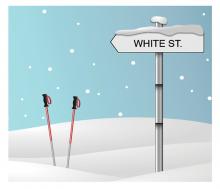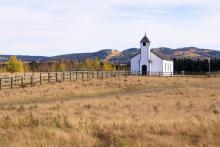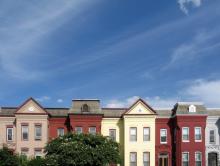gentrification

THE BRIGHT LIGHT of a full moon cast long shadows on the snow as the firefighters walked up to my home. It was 2:30 a.m., and they tramped single file through the narrow trench I had dug, the exact width of a single snow-shovel blade. (I’m familiar with my sidewalk. I know what it looks like, and felt no need to uncover all of it from the two feet of snow that fell in late January. It was called “snowzilla” or “snowmaggedon,” but I preferred to identify this monster snow as a “snonster.” But that sounds like a head cold, and it never really caught on.)
The firefighters were responding to a call I made after awakening to the strong odor of burning. It smelled like leftover barbecue, which is an utter impossibility in my household because when we have barbecue, we eat it greedily while emitting animal-like growls to warn away other family members, then lick the empty plates clean in a state of giddy delirium. There are never leftovers.
(Editor’s note: Okay, we get it. It wasn’t barbecue.)
I rushed outside to see if a nearby home was on fire, and I saw nothing. But the smell was still strong, so I felt I had to notify the authorities. Figuring my editor was still asleep, I dialed 911 instead.

ONE RECENT WINTER day, Nora Howell stepped out of her house in the Sandtown neighborhood of Baltimore and took a walk down the street. People in the predominantly black community did double takes as this white woman promenaded past them in a sundress made of saltine and oyster crackers. Some stared in disbelief. One man doubled over laughing. In the corner coffee shop, one of the regulars warned Howell not to walk by any homeless people because they might just eat her up.
Later Howell, a community artist and director of the neighborhood Jubilee Arts program, set the video footage taken during her walk to Mister Rogers’ classic refrain, “Won’t You Be My Neighbor?” The piece, which emerged out of Howell’s ponderings on what it means to be white living in a black neighborhood, became another part of her answer to a call: to use art to address systemic racism and bring about the kingdom of God.
From Race Riots to White Suburbia and Beyond
In 2001, Howell was an eighth grader living in a biracial community in urban Cincinnati. When race riots erupted after a young black man was shot fatally by a white police officer (sound familiar?), her family took to the streets on a prayer walk through the riots. Howell remembers being shocked and terrified, thinking, “Why do we still have race riots? Cincinnati is so far behind the times.”
In the aftermath, Howell talked with peers at school on the reality of racial tensions and observed with curiosity how white and black churches throughout the city responded. She realized race riots weren’t just a relic of the ’60s. “When you lived in a place where different racial groups interacted daily, [racial tensions] could no longer be denied or ignored,” she said.
Yet when Howell moved to suburban Chicago to attend Wheaton College, conversations on race were largely absent. “I found that very odd,” she said. She got involved in a campus group to promote awareness of racial injustice.
WHEN CECIL WILLIAMS was 8 years old, he imagined murdering a police officer. It’s a jarring way for an influential minister to begin a memoir about radical hope and perseverance. But in a short lifetime of intense oppression, Williams had already internalized heartbreaking lessons of systemic injustice and the righteously violent tendencies that can follow. The budding young leader already nicknamed “Rev” and wise beyond his years also knew that if he could imagine brutality, he could envision a transformed society.
“Imagination is one of the most penetrating and incendiary forces I’ve ever experienced,” he writes in Beyond the Possible: 50 Years of Creating Radical Change at a Community Called Glide, co-authored with his wife and longtime collaborator, Janice Mirikitani. Building on their shared vision over a remarkable half-century, they lead what might be the most exuberant congregation in America. Glide Memorial United Methodist Church and the Glide Foundation are inextricable, legendary San Francisco institutions, the latter one of the city’s largest social service providers and the real-life shelter featured in the 2006 biopic The Pursuit of Happyness.
Writer Dave Eggers sums up Glide in the book’s introduction with a simple but uncomfortable truth: There are very few places in society where someone is not left out. Houses of worship are supposed to make a dream of inclusivity possible, but even the most inspiring visionaries live and lead imperfectly. Eggers proposes that because of the unconditional love necessary for a lasting marriage between two seemingly incompatible leaders—Williams, a black Texas minister with a solid upbringing, and Mirikitani, an agnostic Japanese-American poet from a broken, abusive home—Glide is one of the few radically accepting places where true unconditional love is practiced like the most dogmatic of faiths.

I have spent much time blogging out of frustration with the church, gnashing my teeth over the church’s shortcomings. Some have called this negativity. Some have asked me to be more specific about what I want the church to do. I could not do this before. First, I needed to pinpoint my frustrations and disassemble my previous understanding of church. Out of the rubble of my own disillusionment a vision of something new is beginning to emerge. It is time to share this vision however blurry it may be.
This something new looks like congregations so committed to following Jesus by loving all of God's children that they will pour over their current budget and activities to see what can be altered to make room for greater service to the poor and the outcast. Such churches might come to the conclusion it is unconscionable to pay for the upkeep of a building for the sake of its use a few times a week.
This is a tension-filled topic. As Bergthal made public their intent to disassemble and ultimately tear down their building, many could not understand. For some, there is such a deep attachment to our church building, we would rather it be turned into a house or a barn or just anything as long as it can be saved. I have read the upcoming generation is not as sentimental when it comes to material things. I think this is a good and necessary movement but is sure to bring some tension. Finally, we must realize the church is not about buildings, but about people.

Annie Lowrey's recent New York Times magazine article "Washington's Economic Boom, Financed by You" provides a stimulating look into Washington, D.C.'s "economic boom" of the last few years. As D.C. residents, many of us encounter the ongoing transformation of our city every day. We know the area's economy has grown about three times as much since 2007 as the country — largely a result of expanded government spending (primarily in the form of two foreign wars). We also know that the greater metropolitan region is one of the richest in the country. As Lowrey noted, the Washington metro area has seven out of the top 10 highest-income counties in the U.S., including the three highest.
However, Lowrey only tells one side of the story — the rich side. The "economic boom" has largely passed by D.C.'s poor and working people. By not mentioning D.C.'s grossly high poverty rates, the article is misleading.
Amid Washington's economic boom, there is also massive economic displacement, increased economic inequality, and higher rates of poverty.
Being a socialentrepreneur used to be a lonely endeavor. I grew up believing that to be in business meant leaving your soul at the front door -- being ruthless, shrewd, and above all focused on profitability at any cost. But as a businessman, I found myself less interested in the bottom line of profit than in the bottom line of community impact. For example, I started Busboys and Poets as a restaurant and gathering place, but also a social enterprise -- a business with a conscience -- in Washington, D.C.'s U Street neighborhood.
Having grown up in D.C., I was amazed at the dramatic changes that swept various neighborhoods in the 1990s. The U Street corridor in particular was undergoing some of the most vivid transformation.